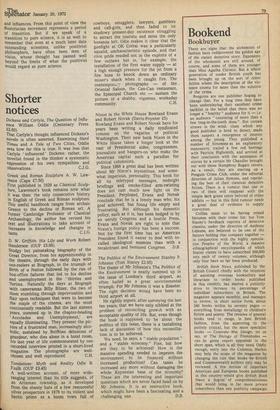Bookend
Bookbuyer
There are signs that the alchemists of fashion have rediscovered the golden age of the classic detective story. Exponents ' of the whodunnit are still around, of course, and some of them are younger than Miss Agatha Christie. But a whole generation of tender British youth has been brought up on the sort of crime fiction where the description of the violence counts for more than the solution of the crime.
Penguins are one publisher hoping to change that. For a long time they have been underplaying their excellent crime backlist in the belief that there was no longer a " healthy " audience for it — i.e.
an audience "consisting of more than a few long-in-the-tooth dons ". But certain straws in the wind, clues which any good publisher is bred to detect, made them suspect a resurgence of interest among the young. They published a number of Simenons as an exploratory manoeuvre, trailed a few red herrings with Patricia Highsmith, and arrived at their conclusion with the assistance of stories by a certain Mr Chandler brought out with those Humphrey Bogart covers. As a result, they are starting up a Penguin Crime Club, under the editorial direction of Julian Symons, and reprinting the best of their classical detective fiction. There is a rumour that one or two of them will reappear with the simple dark green cover beloved of crime addicts — but in this field rumour needs a great deal of evidence to supply conviction.
Collins seem to be having mixed fortunes with their crime list: but Tom Stacey's hardback reprints of detective classics, under the direction of Anthony Lejeune, are believed to be one of the factors holding that company together — in conjunction with the highly speculative Peoples of the World, a massive ethnographical encyclopaedia of which Stacey claims to have subscribed 200,000 sets each of twenty volumes, although only four have so far been produced.
British Book News, published by the British Council chiefly with the intention of assisting overseas booksellers and librarians to order books published in this country, has started a publicity drive to increase its percentage of individual subscribers in Britain. The magazine appears monthly, and manages to review, in short notice form, about 240 books within its seventy pages — everything from metallurgy to children's fiction and poetry. The reviews of general books tend to range, in best British fashion, from the approving to the politely critical, but the more specialist books — Concrete Mix Design, let us say, or The Biology of Trematodes — can be given expert appraisal in the short span, which is all they need. Oddly enough, entry into the Common Market may help the scope of the magazine by changing the rule that books by British and Commonwealth authors only may be reviewed. A few notices of important American and European books published in this country would give British Book News a degree of comprehensiveness that would bring in far more private subscribers than any publicity campaign.


































 Previous page
Previous page